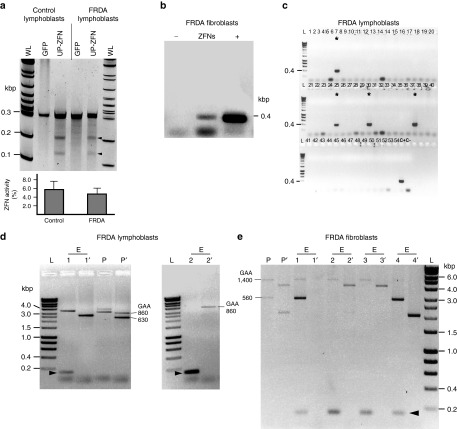Figure 3.
Genetic correction of expanded GAA repeats in FRDA lymphoblasts and fibroblasts. (a) CEL I analysis to determine the efficiency of UP-ZFN cleavage in the heterochromatin region in cells harboring expanded GAAs; FRDA lymphoblasts (GM15850), control lymphoblasts (GM15851); arrowheads indicate expected cleavage products. Quantitative analysis of UP-ZFN activity in FRDA and control lymphoblasts is shown below. WL designates Wide Range DNA marker (Sigma), L—Hyperladder I. (b) Detection of the ZFN-edited alleles in the population of FRDA68 fibroblasts 48 hours post-transfection with UP- and DN-ZFNs (ZFN lane). K562 clone 5 (Figure 2a) was used as a positive control (lane +), whereas a PCR reaction with no template served as a negative control (lane –). (c) Detection of ZFN-edited clones from FRDA lymphoblasts by PCR with UP-F/R primers. Asterisks indicate positive, ZFN-edited clones; C+ positive control (K562 clone 5, Figure 2a), C-negative PCR control. (d) Analysis of the GAA repeat region in two ZFN-edited (E1 and E2) and non-GAA edited clone (P) derived from FRDA lymphoblasts using two PCR primer sets: ZFN-Ext F/R (lanes E1, E2, P) and ZFN-Int (lanes E1′, E2′, and P′) which produce amplicons that differ in the length of the sequences flanking the GAA repeats. The location of all primers relative to the GAA repeats and ZFN cleavage sites is depicted in Supplementary Figure S1. (e) Analysis of the GAA repeat region in identified ZFN-edited and non-GAA edited clones derived from FRDA68 fibroblasts. Clones P, E1, E2, E3, and E4 were analyzed using ZFN-Ext primers; clones P′, E1′, E2′, E3′, and E4′ were amplified with ZFN-Int primers. The short, ~0.2 kbp DNA fragment resulting from ZFN-mediated genetic correction of one of the alleles is indicated by an arrowhead. In some cases, because of the inherent difficulties of amplifying extremely long tracts of GAAs, a long exposure of the gel is required to visualize GAA amplification products (lane E1′). See also Supplementary Figure S6b,c.

